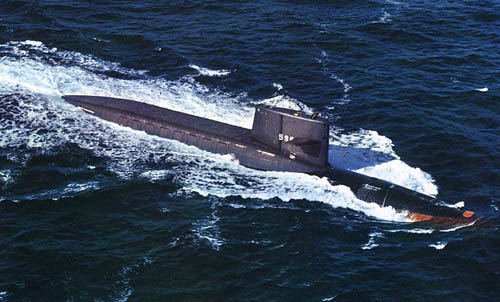George Washington-class (SSBN-598)
Summary
| Origin country | 🇺🇸 United States |
| Category | Submarine |
| Subtype | Nuclear ballistic missile submarine |
| Manufacturer | General Dynamics Electric Boat, Mare Island Naval Shipyard, Newport News Shipbuilding, Portsmouth Naval Shipyard |
| Year commissioned | 1959 |
| Units | SSBN-598 GEORGE WASHINGTON, SSBN-599 PATRICK HENRY, SSBN-600 THEODORE ROOSEVELT, SSBN-601 ROBERT E. LEE, SSBN-602 ABRAHAM LINCOLN |
Description
The USS George Washington (SSBN-598) holds the distinction of being the first operational ballistic missile submarine of the United States. As the lead ship of her class, she was constructed in honor of George Washington, the nation's first president. Her origins trace back to the Electric Boat Division of General Dynamics in Groton, Connecticut, where her keel was laid down on November 1, 1958. Originally intended to be an attack submarine and named Scorpion (SSN-589), she was redesigned mid-construction to include a 130 feet long ballistic missile section, resulting in her rechristening as George Washington.
The submarine's armament included 16 Polaris missiles, marking a significant advancement in naval warfare capabilities. Her design integrated a ballistic missile compartment meant for future reuse in subsequent submarine classes, with a test depth rating greater than other sections of the ship.
George Washington embarked on her maiden voyage to Cape Canaveral, Florida, in June 1960, where she undertook the historic feat of launching the first submerged Polaris missiles in July of the same year. This demonstration of capability sent a message to President Dwight Eisenhower confirming the success of the launch. Following this, she loaded her full complement of missiles and performed continuous deterrent patrols, alternating between her Blue and Gold crews.
Her operational history is marked by traversing 100,000 nautical miles by 1970 and changing theater of operations from the Atlantic to the Pacific, with a home port shift to Pearl Harbor, Hawaii. In April 1981, George Washington was involved in a collision with the Japanese cargo ship Nissho Maru in the East China Sea. While the submarine suffered minor damage and no immediate harm to her crew, the accident had diplomatic repercussions and strained U.S.-Japan relations. The incident led to the reprimanding and relieving of the commanding officer and changes to operational protocols.
Towards the end of her service as a ballistic missile submarine, in 1981, George Washington unloaded her missiles in compliance with arms control treaties and transitioned to an attack submarine role. She executed exercises and provided support for special forces training, even participating in a circumnavigation of South America.
After a notable career spanning 25 years and 55 deterrent patrols, George Washington was decommissioned on January 24, 1985. She was stricken from the Naval Vessel Registry the following year and was eventually recycled at the Puget Sound Naval Shipyard by September 1998.
Technical specifications
| George Washington | |
|---|---|
| Displacement | 6019 tons |
| Displacement submerged | 6888 tons |
| Range | Unlimited, except by food supplies |
| Crew | 112 members |
| Width | 10.0 m (32.8 ft) |
| Length | 116.0 m (380.6 ft) |
| Max. depth | 210 m (689.0 ft) |
| Propulsion | 1 Westinghouse S 5W PWR reactor with a power of 15,000 hp - 1 propeller |
| Armament | 16 UGM-27 Polaris missiles + 6 533mm TLTs |
| Maximum speed | 20 knots |
| Max. speed submerged | 25 knots |
Photo of George Washington class

Silhouette
